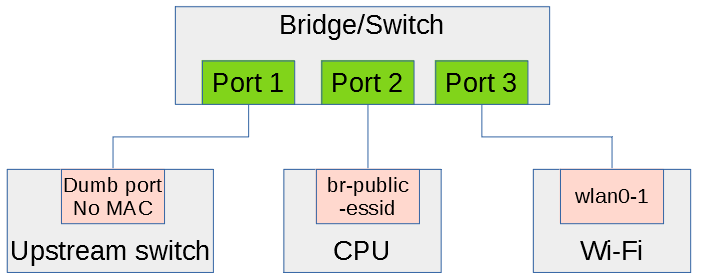/etc/config/network
config interface 'public_essid'
option type 'bridge'
option ifname 'eth1.2766'
option proto none
/etc/config/wireless
config wifi-iface 'public'
option device 'radio0'
option network 'public_essid'
option mode ap
option ssid 'Public'
option encryption none
option isolate 1
root@OpenWrt:~# ip address
[...]
9: br-public_essid: <BROADCAST,MULTICAST,UP,LOWER_UP> mtu 1500 qdisc noqueue state UP qlen 1000
link/ether c0:4a:00:9d:80:93 brd ff:ff:ff:ff:ff:ff
inet6 fe80::c24a:ff:fe9d:8093/64 scope link
valid_lft forever preferred_lft forever
10: eth1.2766@eth1: <BROADCAST,MULTICAST,UP,LOWER_UP> mtu 1500 qdisc noqueue master br-public_essid state UP qlen 1000
link/ether c0:4a:00:9d:80:93 brd ff:ff:ff:ff:ff:ff
17: wlan0-1: <BROADCAST,MULTICAST,UP,LOWER_UP> mtu 1500 qdisc noqueue master br-public_essid state UP qlen 1000
link/ether c2:4a:00:9d:80:92 brd ff:ff:ff:ff:ff:ff
inet6 fe80::c04a:ff:fe9d:8092/64 scope link
valid_lft forever preferred_lft forever
[...]
We have a bridge with 3 interfaces (or a switch with 3 ports). How can 2 of them (br-public_essid and eth1.2766) share a single MAC address of c0:4a:00:9d:80:93 and work? As far as I know all interfaces in the same broadcast domain cannot have duplicated MAC.
